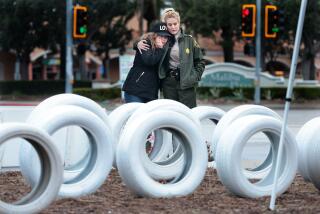Officials Pursuing Ways to Cut Diamond-Lane Offenses
Dear Street Smart:
I sold my car a few months ago, so whenever I need to go somewhere I car-pool with my husband. Naturally, we use the diamond lane whenever we travel the Costa Mesa Freeway.
For years, even when I wasn’t car-pooling, I thought the diamond lane was a terrific idea. It rewards those who make the effort to car-pool. Another reason I like the diamond lane has to do with the recent birth of my baby: Since I live in Corona and my doctor delivers only out of a hospital in Costa Mesa, I was relieved that I never had to worry about getting to the hospital on time--even in rush hour.
What really burns me up is seeing single drivers using the car-pool lane. Mind you, this is not a rare occurrence. At the slightest hint of a slowdown, I see at least three to four single drivers using the car-pool lane. What I don’t see is Highway Patrol officers patrolling the freeway and citing these people. I would think they could generate a fortune in revenue! Without the CHP there as a deterrent, why should anyone bother to obey the law?
I’m sure the CHP can quote a large number of citations given each year for this violation. But whenever I travel the Costa Mesa Freeway, regardless of time of day, I never fail to see drivers violating the law and to notice that there are no CHP officers patrolling the area.
Linda de Bree
Corona
Nine percent of the cars on the Costa Mesa Freeway’s restricted lanes do not contain the required minimum of two people, according to a recent survey by the California Department of Transportation. Caltrans officials are relatively pleased by that figure (and even happier about the 5% violation rate for the San Diego Freeway car-pool lane), but some folks contend that it isn’t good enough.
Most say the CHP is to blame. Well, there’s some good news and some bad news.
First, the good: While the CHP may not be able to snag all of those violators, the agency has boosted its enforcement efforts. In 1989, the CHP allocated more than 6,000 hours of overtime--and a like number is budgeted for 1990--for its officers to use solely on catching car-pool cheats in Orange County.
In addition, Caltrans is planning to add a second “enforcement area” to the Costa Mesa Freeway. These are small breaks in freeway medians where motorcycle officers can safely sit and monitor traffic. There will eventually be three enforcement areas on the Costa Mesa Freeway between the San Diego and Riverside freeways.
Now the bad news: There will never be enough enforcement areas and Highway Patrol officers to catch everyone who zips solo into the car-pool lane. It’s a simple matter of mathematics: There are lots of violators and only a small number of patrol officers.
With that in mind, the Highway Patrol and Caltrans have been looking for ways to better patrol the lanes. Lately, the agencies have been studying the use of video cameras. These would focus on the interior and license plate of each car, and an officer would review the tapes and send out citations.
Motorists irked by car-pool-lane scofflaws and excited by the prospect of their being caught shouldn’t hold their breath, though. Such a system is at least five years away. Moreover, some authorities suggest that privacy and civil liberty questions could sink the video patrols before they start.
Dear Street Smart:
With regard to left-turn signal lights: Some are marked “On Left Arrow Only” and others carry no such marking. I assume that unmarked left-turn signals require only that the driver yield to oncoming traffic and that it is therefore legal to turn left if left arrow is red but the through signal is green.
Merle D. Borman
Dana Point
Your assumption is wrong, according to Steve Kohler, a spokesman for the California Highway Patrol. If an intersection is outfitted with a left-turn arrow lamp, it is legal to turn left only when the arrow is green, never when the arrow is red. The arrow is there so that cars turning left can do so when all oncoming traffic is stopped. Usually, such arrows are part of a special left-turn lane, and more often than not, the post with the turn arrow is outfitted with a sign specifying “On Left Arrow Only.” But not always. You must stop when the arrow is red, even if there is no sign.
More to Read
Sign up for Essential California
The most important California stories and recommendations in your inbox every morning.
You may occasionally receive promotional content from the Los Angeles Times.










